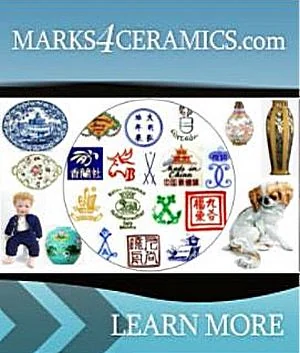Pricing Guides & Dictionary of Makers Marks for Antiques & Collectibles

A few examples of appraisal values for
LIBERATION
Search our price guide for your own treasures
-
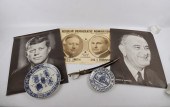 Political posters, souvenir
Political posters, souvenir pottery, sword to include Lyndon B. Johnson poster, Democratic Nomination poster Alfred E. Smith of New York Joe T. Robinson of Arkansas for President and Vice President, John F. Kennedy poster, vintage souvenir Indian sword in blue velvet and brass sheath, Delft Bevrijding van Maastricht Door De Amerikanen WWII plate, 9" dia and 1944 Liberation of Limburg 45th Anniversary Delft charger, 13" dia
Political posters, souvenir
Political posters, souvenir pottery, sword to include Lyndon B. Johnson poster, Democratic Nomination poster Alfred E. Smith of New York Joe T. Robinson of Arkansas for President and Vice President, John F. Kennedy poster, vintage souvenir Indian sword in blue velvet and brass sheath, Delft Bevrijding van Maastricht Door De Amerikanen WWII plate, 9" dia and 1944 Liberation of Limburg 45th Anniversary Delft charger, 13" dia -
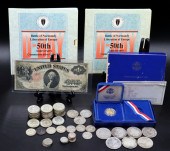 BULLION. JUNK SILVER AND GOLD
BULLION. JUNK SILVER AND GOLD BULLION GROUPING. Including a 1986 $5 W (West Point struck) Statue of Liberty Centennial commemorative gold coin with a fineness of .900 in OGP (original government packaging), the total mintage for this date & mint mark: 404,013; (2) Battle of Normandy Liberation of Europe 50th anniversary commemorative coin sets, each set is comprised of (1)1991-1995 $1 D (Denver struck) 50th Anniversary of World War II commemorative silver dollar, the total mintage for this date & mint mark: 107,240; and a 1993 1 Fr. Normandy Invasion commemorative silver coin; (2) 1890 O $1 Morgan silver dollars; (1) 1878 S $1 Morgan silver dollar; (1) 1888 S $1 Morgan silver dollar; (1) 1889 O $1 Morgan silver dollar; (1) 1879 $1 (Philadelphia struck) Morgan silver dollar; (1) 1922 $1 (Philadelphia struck) Peace silver dollar; (33) full date $16.50 face value 40% silver random date1965-1970 Kennedy half dollars; (6) full date $1.50 face value 90% silver random date Washington quarters; (1) no date .25 C face value 90% silver Washington quarter; (1) no date .25 C face value 90% silver Standing Liberty quarter; (11) full date $1.10 face value 90% silver random date Roosevelt dimes; (5) full date .50 C face value 90% silver random date Mercury dimes; and (3) no date Buffalo Head nickels. Accompanied by a series of 1917 $1 Legal Tender (Sawhorse) Fr# 39. with signatures Speelman/White and serial #: T56125714A. Total approx. weight of the junk silver is 13.984 troy oz (gross); total approx. weight of the $5 gold coin is 8.36 grams; total approx. weight of the French Francs is 44.4 grams (gross); and the total approx. weight of the 1991-1995 WWII silver dollars is 53.46 grams (gross). From a Thornwood, NY estate. Dimensions: $5 Statue Of Liberty gold coin measures approx. 21.60mm in diameter. Condition: All coins are circulated. Sawhorse exhibits soiling, creases, folds, a split corner, and potential pencil marks. OGP exhibits staining and soiling, coin is encapsulated.
BULLION. JUNK SILVER AND GOLD
BULLION. JUNK SILVER AND GOLD BULLION GROUPING. Including a 1986 $5 W (West Point struck) Statue of Liberty Centennial commemorative gold coin with a fineness of .900 in OGP (original government packaging), the total mintage for this date & mint mark: 404,013; (2) Battle of Normandy Liberation of Europe 50th anniversary commemorative coin sets, each set is comprised of (1)1991-1995 $1 D (Denver struck) 50th Anniversary of World War II commemorative silver dollar, the total mintage for this date & mint mark: 107,240; and a 1993 1 Fr. Normandy Invasion commemorative silver coin; (2) 1890 O $1 Morgan silver dollars; (1) 1878 S $1 Morgan silver dollar; (1) 1888 S $1 Morgan silver dollar; (1) 1889 O $1 Morgan silver dollar; (1) 1879 $1 (Philadelphia struck) Morgan silver dollar; (1) 1922 $1 (Philadelphia struck) Peace silver dollar; (33) full date $16.50 face value 40% silver random date1965-1970 Kennedy half dollars; (6) full date $1.50 face value 90% silver random date Washington quarters; (1) no date .25 C face value 90% silver Washington quarter; (1) no date .25 C face value 90% silver Standing Liberty quarter; (11) full date $1.10 face value 90% silver random date Roosevelt dimes; (5) full date .50 C face value 90% silver random date Mercury dimes; and (3) no date Buffalo Head nickels. Accompanied by a series of 1917 $1 Legal Tender (Sawhorse) Fr# 39. with signatures Speelman/White and serial #: T56125714A. Total approx. weight of the junk silver is 13.984 troy oz (gross); total approx. weight of the $5 gold coin is 8.36 grams; total approx. weight of the French Francs is 44.4 grams (gross); and the total approx. weight of the 1991-1995 WWII silver dollars is 53.46 grams (gross). From a Thornwood, NY estate. Dimensions: $5 Statue Of Liberty gold coin measures approx. 21.60mm in diameter. Condition: All coins are circulated. Sawhorse exhibits soiling, creases, folds, a split corner, and potential pencil marks. OGP exhibits staining and soiling, coin is encapsulated. -
 ARTHUR FITZWILLIAM TAIT
ARTHUR FITZWILLIAM TAIT (1819-1905)Quail and Chicks, 1867 signed and dated "AF Tait N A 1867" lower right oil on board, 10 by 14 in. signed and dated on back Kennedy & Co., New York and Winsor & Newton labels on back This painting is number 67.5 in Henry Marsh's Tait checklist. This little gem recalls Tait's famous "The Cares of a Family," with a pair of attentive quail and six baby chicks framed by delicate grasses and flowers. Known as one of America’s earliest sporting artists, Arthur Fitzwilliam Tait was born in Liverpool, England, in 1819. From an early age, he was interested in both art and the outdoors. Tait worked for the firm of Thomas Agnew, a famous art dealer and lithographer in Manchester, trained in lithography and drawing, and explored the open land around the city. However, many of the most beautiful vistas and hunting grounds were private and off limits. While working for the art firm, Tait was exposed to the works of Edwin Landseer (1802-1873), Richard Ansdell (1818-1885), and John Frederick Herring (1815-1907), among others. In Liverpool, beginning in 1843, Tait spent time with fellow artist George Catlin (1796-1872), which may have whetted the young artist’s appetite to explore life in America. Catlin, who was twenty-three years older than Tait, had spent much of the previous decade living in the American West chronicling the lives of Native Americans through his careful drawings and sketches of their clothing, weapons, and ceremonies. There is little doubt that Catlin's stories would have captivated the young and talented Tait. In 1850 Tait boarded a boat with his wife and came to America. By 1852 Tait was pursuing his interests in wildlife and hunting, based on the subject matter of his works. He worked from a studio in New York City, but spent a great deal of time on Long Lake in the Adirondacks, where he acquired skills as an angler, hunter, and keen observer of wildlife. These skills were as important for Tait’s art as his fine ability with brush and pigment, since they gave an authenticity to his portrayals of outdoor life which was virtually unrivaled at the time. His relative freedom to paint wherever he wanted in the vast public lands of New York was obviously liberating to the artist, who had felt confined by the strict laws governing trespassing and hunting on private property in England. With this liberation and experience of the outdoors, Tait’s artistic career flourished. In 1852, only two years after Tait arrived in New York, Nathaniel Currier (1813-1888) and James Merritt Ives (1824-1895) purchased the first of many works from the budding artist. In that same year, Tait was asked to hang a half-dozen works at the National Academy of Design’s annual exhibition. By 1854 he had achieved an associate membership and four years later he became a full member. Editions of Tait’s works for Currier and Ives were reproduced by the thousands and formed some of America’s most iconic images of the Victorian era. The exceptionally popular "American Field Sports" series showcased Tait’s abilities as an upland bird and dog painter and included the four lithographs "A Chance for Both Barrels," "Flushed," "On a Point," and "Retrieving." These hunting scenes, along with his camping and woodland scenes, resonated with the public as an integral part of the American experience and continue to inform us of our history as a nation. Seminal works by Tait, such as "An Anxious Moment," "A Tight Fix," and "Trappers at Fault: Looking for the Trail," have become embedded as part of our heritage and serve as signposts along our path as a nation. Today, Tait's wilderness, frontier, and wildlife scenes hang in some of the most prominent museums and private collections, including the permanent collections of the Addison Gallery of American Art, Andover, Massachusetts; the Adirondack Museum, Blue Mountain Lake, New York; the American Museum of Western Art, Denver, Colorado; the Amon Carter Museum, Fort Worth, Texas; the Brooklyn Museum, New York; the Corcoran Gallery of Art, Washington, DC; the Denver Art Museum, Colorado; the Metropolitan Museum of Art, New York; the National Museum of Racing, Saratoga Springs, New York; the Shelburne Museum, Vermont; the Yale University Art Gallery, New Haven, Connecticut; the Tate Gallery, London; and the Victoria & Albert Museum, London, among others. Provenance: Charles Porter Schutt Collection, acquired from The Old Print Shop, New York Sarah S. Harrison Collection, by descent Renee du Pont Harrison Collection, by descent Literature: Henry M. Reed, "The A. B. Frost Book," Charleston, SC, 1993, p. 87, illustrated. Henry M. Reed, "The A. B. Frost Book," Rutland, VT, 1967, illustrated. Henry W. Lanier, "A. B. Frost The American Sportsman's Artist," New York, 1933, illustrated.
ARTHUR FITZWILLIAM TAIT
ARTHUR FITZWILLIAM TAIT (1819-1905)Quail and Chicks, 1867 signed and dated "AF Tait N A 1867" lower right oil on board, 10 by 14 in. signed and dated on back Kennedy & Co., New York and Winsor & Newton labels on back This painting is number 67.5 in Henry Marsh's Tait checklist. This little gem recalls Tait's famous "The Cares of a Family," with a pair of attentive quail and six baby chicks framed by delicate grasses and flowers. Known as one of America’s earliest sporting artists, Arthur Fitzwilliam Tait was born in Liverpool, England, in 1819. From an early age, he was interested in both art and the outdoors. Tait worked for the firm of Thomas Agnew, a famous art dealer and lithographer in Manchester, trained in lithography and drawing, and explored the open land around the city. However, many of the most beautiful vistas and hunting grounds were private and off limits. While working for the art firm, Tait was exposed to the works of Edwin Landseer (1802-1873), Richard Ansdell (1818-1885), and John Frederick Herring (1815-1907), among others. In Liverpool, beginning in 1843, Tait spent time with fellow artist George Catlin (1796-1872), which may have whetted the young artist’s appetite to explore life in America. Catlin, who was twenty-three years older than Tait, had spent much of the previous decade living in the American West chronicling the lives of Native Americans through his careful drawings and sketches of their clothing, weapons, and ceremonies. There is little doubt that Catlin's stories would have captivated the young and talented Tait. In 1850 Tait boarded a boat with his wife and came to America. By 1852 Tait was pursuing his interests in wildlife and hunting, based on the subject matter of his works. He worked from a studio in New York City, but spent a great deal of time on Long Lake in the Adirondacks, where he acquired skills as an angler, hunter, and keen observer of wildlife. These skills were as important for Tait’s art as his fine ability with brush and pigment, since they gave an authenticity to his portrayals of outdoor life which was virtually unrivaled at the time. His relative freedom to paint wherever he wanted in the vast public lands of New York was obviously liberating to the artist, who had felt confined by the strict laws governing trespassing and hunting on private property in England. With this liberation and experience of the outdoors, Tait’s artistic career flourished. In 1852, only two years after Tait arrived in New York, Nathaniel Currier (1813-1888) and James Merritt Ives (1824-1895) purchased the first of many works from the budding artist. In that same year, Tait was asked to hang a half-dozen works at the National Academy of Design’s annual exhibition. By 1854 he had achieved an associate membership and four years later he became a full member. Editions of Tait’s works for Currier and Ives were reproduced by the thousands and formed some of America’s most iconic images of the Victorian era. The exceptionally popular "American Field Sports" series showcased Tait’s abilities as an upland bird and dog painter and included the four lithographs "A Chance for Both Barrels," "Flushed," "On a Point," and "Retrieving." These hunting scenes, along with his camping and woodland scenes, resonated with the public as an integral part of the American experience and continue to inform us of our history as a nation. Seminal works by Tait, such as "An Anxious Moment," "A Tight Fix," and "Trappers at Fault: Looking for the Trail," have become embedded as part of our heritage and serve as signposts along our path as a nation. Today, Tait's wilderness, frontier, and wildlife scenes hang in some of the most prominent museums and private collections, including the permanent collections of the Addison Gallery of American Art, Andover, Massachusetts; the Adirondack Museum, Blue Mountain Lake, New York; the American Museum of Western Art, Denver, Colorado; the Amon Carter Museum, Fort Worth, Texas; the Brooklyn Museum, New York; the Corcoran Gallery of Art, Washington, DC; the Denver Art Museum, Colorado; the Metropolitan Museum of Art, New York; the National Museum of Racing, Saratoga Springs, New York; the Shelburne Museum, Vermont; the Yale University Art Gallery, New Haven, Connecticut; the Tate Gallery, London; and the Victoria & Albert Museum, London, among others. Provenance: Charles Porter Schutt Collection, acquired from The Old Print Shop, New York Sarah S. Harrison Collection, by descent Renee du Pont Harrison Collection, by descent Literature: Henry M. Reed, "The A. B. Frost Book," Charleston, SC, 1993, p. 87, illustrated. Henry M. Reed, "The A. B. Frost Book," Rutland, VT, 1967, illustrated. Henry W. Lanier, "A. B. Frost The American Sportsman's Artist," New York, 1933, illustrated. -
 ARTHUR FITZWILLIAM TAIT
ARTHUR FITZWILLIAM TAIT (1819-1905)On the Qui Vive!, 1871 signed and dated "A.F. Tait N.Y. 1871" lower right oil on panel, 12 by 16 in. numbered, titled, signed, and inscribed on back "On the Qui Vive" is old slang for "on the alert," another common title for Tait's deer paintings. Depicting four deer with flying mallards behind on the shore of Racquette Lake in the Adirondacks, this bright and lively jewel of a painting reveals the artist at the peak of his painting abilities. This important work is titled and described in Tait's 1871 register entry as No. 19. It is illustrated in Cadbury and Marsh's text on the artist: "[No.] 19. Deer. on the qui vive! Buck & 3 Does. 16 x 12. Mr. Dorman, 109 E 27th St. Del'd to him March 17th & paid same time [$125.00] in his own frame by [blank]." Known as one of America’s earliest sporting artists, Arthur Fitzgerald Tait was born in Liverpool, England, in 1819. From an early age, he was interested in both art and the outdoors. Tait worked for the firm of Thomas Agnew, a famous art dealer and lithographer in Manchester, trained in lithography and drawing, and explored the open land around the city. However, many of the most beautiful vistas and hunting grounds were private and off limits. While in the employ of the art firm, Tait was exposed to the works of Edwin Landseer (1802-1873), Richard Ansdell (1818-1885), and John Frederick Herring (1815-1907), among others. In Liverpool, beginning in 1843, Tait spent time with fellow artist George Catlin (1796-1872), which may have whetted the young artist’s appetite to explore life in America. Catlin, who was twenty-three years older than Tait, had spent much of the previous decade living in the American West chronicling the lives of Native Americans through his careful drawings and sketches of their clothing, weapons, and ceremonies. There is little doubt that Catlin's stories would have captivated the young and talented Tait. In 1850 Tait boarded a boat with his wife and came to America. By 1852 Tait was pursuing his interests in wildlife and hunting, based on the subject matter of his works. He worked from a studio in New York City, but spent a great deal of time on Long Lake in the Adirondacks, where he acquired skills as an angler, hunter, and keen observer of wildlife. These skills were as important for Tait’s art as his fine ability with brush and pigment, since they gave an authenticity to his portrayals of outdoor life which was virtually unrivalled at the time. His relative freedom to paint wherever he wanted in the vast public lands of New York was obviously liberating to the artist, who had felt confined by the strict laws governing trespassing and hunting on private property in England. With this liberation and experience of the outdoors, Tait’s artistic career flourished. In 1852, only two years after Tait arrived in New York, Nathaniel Currier (1813-1888) and James Merritt Ives (1824-1895) purchased the first of many works from the budding artist. In that same year, Tait was asked to hang a half-dozen works at the National Academy of Design’s annual exhibition. By 1854 he had achieved an associate membership and four years later he became a full member. Editions of Tait’s works for Currier and Ives were reproduced by the thousands and formed some of America’s most iconic images of the Victorian era. The exceptionally popular "American Field Sports" series showcased Tait’s abilities as an upland bird and dog painter and included the four lithographs "A Chance for Both Barrels," "Flushed," "On a Point," and "Retrieving." These hunting scenes, along with his camping and woodland scenes, resonated with the public as an integral part of the American experience and continue to inform us of our history as a nation. Seminal works by Tait, such as "An Anxious Moment," "A Tight Fix," and "Trappers at Fault: Looking for the Trail," have become embedded as part of our heritage and serve as signposts along our path as a nation. Today, Tait's wilderness, frontier, and wildlife scenes hang in some of the most prominent museums and private collections, including the permanent collections of the Addison Gallery of American Art, Andover, Massachusetts; the Adirondack Museum, Blue Mountain Lake, New York; the American Museum of Western Art, Denver, Colorado; the Amon Carter Museum, Fort Worth, Texas; the Brooklyn Museum, New York; the Corcoran Gallery of Art, Washington, DC; the Denver Art Museum, Colorado; the Metropolitan Museum of Art, New York; the National Museum of Racing, Saratoga Springs, New York; the Shelburne Museum, Vermont; the Yale University Art Gallery, New Haven, Connecticut; the Tate Gallery, London; and the Victoria & Albert Museum, London, among others. Provenance: Dorman Collection Mrs. J. Augustus Barnard Collection The Metropolitan Museum of Art, New York, 1979 Private Collection Literature: Warder H. Cadbury and Henry F. Marsh, "Arthur Fitzwilliam Tait: Artist in the Adirondacks," Newark, DE, 1986, pp. 215-16, no. 71.10, illustrated.
ARTHUR FITZWILLIAM TAIT
ARTHUR FITZWILLIAM TAIT (1819-1905)On the Qui Vive!, 1871 signed and dated "A.F. Tait N.Y. 1871" lower right oil on panel, 12 by 16 in. numbered, titled, signed, and inscribed on back "On the Qui Vive" is old slang for "on the alert," another common title for Tait's deer paintings. Depicting four deer with flying mallards behind on the shore of Racquette Lake in the Adirondacks, this bright and lively jewel of a painting reveals the artist at the peak of his painting abilities. This important work is titled and described in Tait's 1871 register entry as No. 19. It is illustrated in Cadbury and Marsh's text on the artist: "[No.] 19. Deer. on the qui vive! Buck & 3 Does. 16 x 12. Mr. Dorman, 109 E 27th St. Del'd to him March 17th & paid same time [$125.00] in his own frame by [blank]." Known as one of America’s earliest sporting artists, Arthur Fitzgerald Tait was born in Liverpool, England, in 1819. From an early age, he was interested in both art and the outdoors. Tait worked for the firm of Thomas Agnew, a famous art dealer and lithographer in Manchester, trained in lithography and drawing, and explored the open land around the city. However, many of the most beautiful vistas and hunting grounds were private and off limits. While in the employ of the art firm, Tait was exposed to the works of Edwin Landseer (1802-1873), Richard Ansdell (1818-1885), and John Frederick Herring (1815-1907), among others. In Liverpool, beginning in 1843, Tait spent time with fellow artist George Catlin (1796-1872), which may have whetted the young artist’s appetite to explore life in America. Catlin, who was twenty-three years older than Tait, had spent much of the previous decade living in the American West chronicling the lives of Native Americans through his careful drawings and sketches of their clothing, weapons, and ceremonies. There is little doubt that Catlin's stories would have captivated the young and talented Tait. In 1850 Tait boarded a boat with his wife and came to America. By 1852 Tait was pursuing his interests in wildlife and hunting, based on the subject matter of his works. He worked from a studio in New York City, but spent a great deal of time on Long Lake in the Adirondacks, where he acquired skills as an angler, hunter, and keen observer of wildlife. These skills were as important for Tait’s art as his fine ability with brush and pigment, since they gave an authenticity to his portrayals of outdoor life which was virtually unrivalled at the time. His relative freedom to paint wherever he wanted in the vast public lands of New York was obviously liberating to the artist, who had felt confined by the strict laws governing trespassing and hunting on private property in England. With this liberation and experience of the outdoors, Tait’s artistic career flourished. In 1852, only two years after Tait arrived in New York, Nathaniel Currier (1813-1888) and James Merritt Ives (1824-1895) purchased the first of many works from the budding artist. In that same year, Tait was asked to hang a half-dozen works at the National Academy of Design’s annual exhibition. By 1854 he had achieved an associate membership and four years later he became a full member. Editions of Tait’s works for Currier and Ives were reproduced by the thousands and formed some of America’s most iconic images of the Victorian era. The exceptionally popular "American Field Sports" series showcased Tait’s abilities as an upland bird and dog painter and included the four lithographs "A Chance for Both Barrels," "Flushed," "On a Point," and "Retrieving." These hunting scenes, along with his camping and woodland scenes, resonated with the public as an integral part of the American experience and continue to inform us of our history as a nation. Seminal works by Tait, such as "An Anxious Moment," "A Tight Fix," and "Trappers at Fault: Looking for the Trail," have become embedded as part of our heritage and serve as signposts along our path as a nation. Today, Tait's wilderness, frontier, and wildlife scenes hang in some of the most prominent museums and private collections, including the permanent collections of the Addison Gallery of American Art, Andover, Massachusetts; the Adirondack Museum, Blue Mountain Lake, New York; the American Museum of Western Art, Denver, Colorado; the Amon Carter Museum, Fort Worth, Texas; the Brooklyn Museum, New York; the Corcoran Gallery of Art, Washington, DC; the Denver Art Museum, Colorado; the Metropolitan Museum of Art, New York; the National Museum of Racing, Saratoga Springs, New York; the Shelburne Museum, Vermont; the Yale University Art Gallery, New Haven, Connecticut; the Tate Gallery, London; and the Victoria & Albert Museum, London, among others. Provenance: Dorman Collection Mrs. J. Augustus Barnard Collection The Metropolitan Museum of Art, New York, 1979 Private Collection Literature: Warder H. Cadbury and Henry F. Marsh, "Arthur Fitzwilliam Tait: Artist in the Adirondacks," Newark, DE, 1986, pp. 215-16, no. 71.10, illustrated. -
 FINLAND: FIVE AWARDS Finland.
FINLAND: FIVE AWARDS Finland. Commemorative Medal of the War of Liberation (Vapaussodan Muistomitali) 1918 by Sporrong of Stockholm Finland. Silver Medal of Merit of the Finnish Society of Economics (Suomen Talousseura); Finland. War Veterans’ Association Medal of Merit (Sotaveteraaniliiton ansiomitali) with ‘XXV’ clasp for 25 years’ membership (2); Finland. Mannerheim League for Child Welfare, Silver Badge of Merit (Mannerheimin Lastensuojeluliiton hopeinen ansiomerkki), numbered ‘357’ and with silver purity mark ‘813H’ (5)
FINLAND: FIVE AWARDS Finland.
FINLAND: FIVE AWARDS Finland. Commemorative Medal of the War of Liberation (Vapaussodan Muistomitali) 1918 by Sporrong of Stockholm Finland. Silver Medal of Merit of the Finnish Society of Economics (Suomen Talousseura); Finland. War Veterans’ Association Medal of Merit (Sotaveteraaniliiton ansiomitali) with ‘XXV’ clasp for 25 years’ membership (2); Finland. Mannerheim League for Child Welfare, Silver Badge of Merit (Mannerheimin Lastensuojeluliiton hopeinen ansiomerkki), numbered ‘357’ and with silver purity mark ‘813H’ (5) -
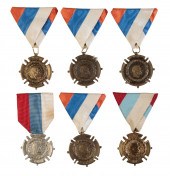 SERBIA. A COLLECTION OF
SERBIA. A COLLECTION OF COMMEMORATIVE CROSSES FOR THE WAR OF LIBERATION AND UNION, 1914-1918 Serbia. Commemorative Cross for the War of Liberation and Union, 1914-1918 (6, one a cast copy) (6)
SERBIA. A COLLECTION OF
SERBIA. A COLLECTION OF COMMEMORATIVE CROSSES FOR THE WAR OF LIBERATION AND UNION, 1914-1918 Serbia. Commemorative Cross for the War of Liberation and Union, 1914-1918 (6, one a cast copy) (6) -
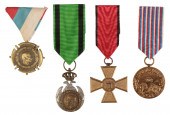 SERBIA. FOUR MEDALS, 1912-1918
SERBIA. FOUR MEDALS, 1912-1918 Serbia. Commemorative Medal for the First Balkan War, 1912, ‘gold’ medal by Huguenin Frères of Le Locle, Switzerland; Serbia. Commemorative Cross for the Serbo-Turkish War of 1913 for combatants; Serbia. Commemorative Medal for Loyalty to the Fatherland: Albanian Retreat Medal, 1915; Serbia. Commemorative Cross for the War of Liberation and Union, 1914-1918, silvered cast copy (4)
SERBIA. FOUR MEDALS, 1912-1918
SERBIA. FOUR MEDALS, 1912-1918 Serbia. Commemorative Medal for the First Balkan War, 1912, ‘gold’ medal by Huguenin Frères of Le Locle, Switzerland; Serbia. Commemorative Cross for the Serbo-Turkish War of 1913 for combatants; Serbia. Commemorative Medal for Loyalty to the Fatherland: Albanian Retreat Medal, 1915; Serbia. Commemorative Cross for the War of Liberation and Union, 1914-1918, silvered cast copy (4) -
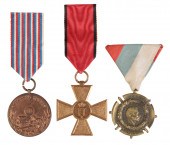 SERBIA. THREE MEDALS, 1912-1918
SERBIA. THREE MEDALS, 1912-1918 Serbia. Commemorative Medal for the First Balkan War, 1912, ‘gold’ medal by Huguenin Frères of Le Locle, Switzerland; Serbia. Commemorative Cross for the Serbo-Turkish War of 1913 for combatants; Serbia. Commemorative Cross for the War of Liberation and Union, 1914-1918 (3)
SERBIA. THREE MEDALS, 1912-1918
SERBIA. THREE MEDALS, 1912-1918 Serbia. Commemorative Medal for the First Balkan War, 1912, ‘gold’ medal by Huguenin Frères of Le Locle, Switzerland; Serbia. Commemorative Cross for the Serbo-Turkish War of 1913 for combatants; Serbia. Commemorative Cross for the War of Liberation and Union, 1914-1918 (3) -
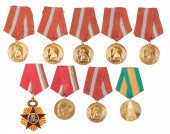 BULGARIA: MEDALS 1945-1991
BULGARIA: MEDALS 1945-1991 Bulgaria. Jubilee Medal for the 100th Anniversary of the Liberation of Bulgaria from Ottoman Domination, 1878-1978; Bulgaria. Medal Commemorative of the Centenary of Sofia as the Capital of Bulgaria; Bulgaria. Jubilee Medal for the 100th Anniversary of the Birth of Georgi Dimitrov, 1982; Bulgaria. dal for Military Merit (6) (9)
BULGARIA: MEDALS 1945-1991
BULGARIA: MEDALS 1945-1991 Bulgaria. Jubilee Medal for the 100th Anniversary of the Liberation of Bulgaria from Ottoman Domination, 1878-1978; Bulgaria. Medal Commemorative of the Centenary of Sofia as the Capital of Bulgaria; Bulgaria. Jubilee Medal for the 100th Anniversary of the Birth of Georgi Dimitrov, 1982; Bulgaria. dal for Military Merit (6) (9) -
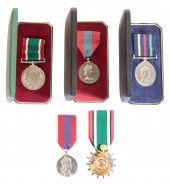 A LOT OF FOUR BRITISH MEDALS EII
A LOT OF FOUR BRITISH MEDALS EII 1953 Coronation Medal; Woman's Volunteer Service Medal; EII Civil Defence LSGC; EII Imperial Service Medal to Ewart Booth Page; Kuwait Liberation Medal
A LOT OF FOUR BRITISH MEDALS EII
A LOT OF FOUR BRITISH MEDALS EII 1953 Coronation Medal; Woman's Volunteer Service Medal; EII Civil Defence LSGC; EII Imperial Service Medal to Ewart Booth Page; Kuwait Liberation Medal -
 A COLLECTION OF CENTRAL AND EASTERN
A COLLECTION OF CENTRAL AND EASTERN EUROPEAN MINIATURE MEDALS Austria. Karl Troop Cross (Karl-Truppen-Kreuz) 1916 (2); Bulgaria. Commemorative Medal for the War of 1915-1918; Hungary. Commemorative Medal for World War I for combatants (Haborús Emlékérem kardokkal és sisakkal) (3); Hungary. Medal with the Holy Crown of Hungary ‘Signum Laudis’ (Magyar Koronás Érem) 1922-1945 issue; Hungary. Commemorative Medal for the Liberation of Transylvania (Erdélyi Emlékérem) 1940;
A COLLECTION OF CENTRAL AND EASTERN
A COLLECTION OF CENTRAL AND EASTERN EUROPEAN MINIATURE MEDALS Austria. Karl Troop Cross (Karl-Truppen-Kreuz) 1916 (2); Bulgaria. Commemorative Medal for the War of 1915-1918; Hungary. Commemorative Medal for World War I for combatants (Haborús Emlékérem kardokkal és sisakkal) (3); Hungary. Medal with the Holy Crown of Hungary ‘Signum Laudis’ (Magyar Koronás Érem) 1922-1945 issue; Hungary. Commemorative Medal for the Liberation of Transylvania (Erdélyi Emlékérem) 1940; -
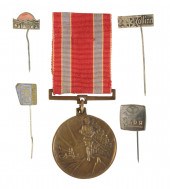 LATVIA. COMMEMORATIVE MEDAL FOR THE
LATVIA. COMMEMORATIVE MEDAL FOR THE 10TH ANNIVERSARY OF THE BATTLES FOR THE LIBERATION, 1928 TOGETHER WITH FOUR STICKPINS Latvia. Commemorative Medal for the 10th Anniversary of the Battles for the Liberation of the Republic of Latvia (Latvijas Republikas atbr?vošanas c??u 10 gadu jubilejas piemi?as meda?a), 1928. The Medal was created in 1928 to be awarded to Latvian citizens and others who served in the national army during War of Liberation from 18 November 1918 to 11 August 1920. Estonia. Silvered metal stickpin ‘Tallinn’ Estonia. Enamel stickpin ‘Tallinn’
LATVIA. COMMEMORATIVE MEDAL FOR THE
LATVIA. COMMEMORATIVE MEDAL FOR THE 10TH ANNIVERSARY OF THE BATTLES FOR THE LIBERATION, 1928 TOGETHER WITH FOUR STICKPINS Latvia. Commemorative Medal for the 10th Anniversary of the Battles for the Liberation of the Republic of Latvia (Latvijas Republikas atbr?vošanas c??u 10 gadu jubilejas piemi?as meda?a), 1928. The Medal was created in 1928 to be awarded to Latvian citizens and others who served in the national army during War of Liberation from 18 November 1918 to 11 August 1920. Estonia. Silvered metal stickpin ‘Tallinn’ Estonia. Enamel stickpin ‘Tallinn’ -
 SERBIA. MEDAL FOR BRAVERY,
SERBIA. MEDAL FOR BRAVERY, 1877-1878 The Medal was instituted on 15 (27) February 1878 and awarded to officers, non-commissioned officers and other ranks for acts of bravery on the field of battle in the war of liberation against Ottoman Turkey of 1877 to 1878. The Medal is rare.
SERBIA. MEDAL FOR BRAVERY,
SERBIA. MEDAL FOR BRAVERY, 1877-1878 The Medal was instituted on 15 (27) February 1878 and awarded to officers, non-commissioned officers and other ranks for acts of bravery on the field of battle in the war of liberation against Ottoman Turkey of 1877 to 1878. The Medal is rare. -
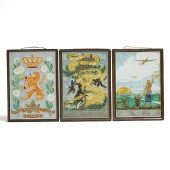 Three WWII Era Delft Tiles, 1943/5
Three WWII Era Delft Tiles, 1943/5 the first commemorating the birth of Princess Margriet of the Netherlands, in Ottawa, 1942, the others celebrating RAF food drop campaigns and the Dutch liberation from German occupation each 7.75 x 5.75 in — 19.7 x 14.6 cm
Three WWII Era Delft Tiles, 1943/5
Three WWII Era Delft Tiles, 1943/5 the first commemorating the birth of Princess Margriet of the Netherlands, in Ottawa, 1942, the others celebrating RAF food drop campaigns and the Dutch liberation from German occupation each 7.75 x 5.75 in — 19.7 x 14.6 cm -
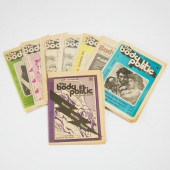 The Body Politic Gay Liberation
The Body Politic Gay Liberation Magazine: Eight Early Editions, 1972-1977 tabloid format, including issue nos. 2 (x2), 3, 4, 5 and 6 dated 1972, issue no. 19, 1975 and no. 30, 1977 each 12 x 8.5 in — 30.5 x 21.6 cm
The Body Politic Gay Liberation
The Body Politic Gay Liberation Magazine: Eight Early Editions, 1972-1977 tabloid format, including issue nos. 2 (x2), 3, 4, 5 and 6 dated 1972, issue no. 19, 1975 and no. 30, 1977 each 12 x 8.5 in — 30.5 x 21.6 cm -
 ANTIQUE ETHEL WRIGHT LITHOGRAPHA
ANTIQUE ETHEL WRIGHT LITHOGRAPHA lithographic image of six women, ca. 1900-1905. Ethel Wright (1866-1939) was an illustrator for Success Magazine in its early days, and this image bears a striking compositional?resemblance to her artwork for the June 1902?cover of Success, a portrayal of strong women with an ethos of women's liberation. Sheet size 10 x 13 inches, in a period frame that measures 13.75 x 17 inches. Condition Not observed out of frame. Overall fading/toning.
ANTIQUE ETHEL WRIGHT LITHOGRAPHA
ANTIQUE ETHEL WRIGHT LITHOGRAPHA lithographic image of six women, ca. 1900-1905. Ethel Wright (1866-1939) was an illustrator for Success Magazine in its early days, and this image bears a striking compositional?resemblance to her artwork for the June 1902?cover of Success, a portrayal of strong women with an ethos of women's liberation. Sheet size 10 x 13 inches, in a period frame that measures 13.75 x 17 inches. Condition Not observed out of frame. Overall fading/toning. -
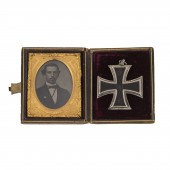 (LOT OF 2) MILITARY EPHEMERA
(LOT OF 2) MILITARY EPHEMERA ITEMS (lot of 2) Military ephemera items, the first cased photo of an Union soldier 3"h x 2.5"w; the second a Prussian style iron cross, the medal inscribed on one side "1813" to commemorate the War of Liberation against Napoleon,; the other side "1, 914" to coincide with the beginning of the Great War of 1914-1918, 1.75"h
(LOT OF 2) MILITARY EPHEMERA
(LOT OF 2) MILITARY EPHEMERA ITEMS (lot of 2) Military ephemera items, the first cased photo of an Union soldier 3"h x 2.5"w; the second a Prussian style iron cross, the medal inscribed on one side "1813" to commemorate the War of Liberation against Napoleon,; the other side "1, 914" to coincide with the beginning of the Great War of 1914-1918, 1.75"h -
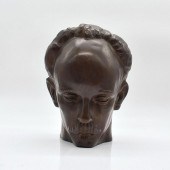 VINTAGE BRONZE BUST OF JOSE
VINTAGE BRONZE BUST OF JOSE MARTIBronze sculpted bust modelled after Cuban nationalist and poet Jose Marti. Rich brown patina finish. Unmarked. Jose Marti was a Cuban nationalist, poet, philosopher, essayist, journalist, translator, professor, and publisher. Jose is considered a Cuban national hero because of his role in the liberation of his country from Spain and is well known as an important figure in Latin American literature. #josemarti #cuba #cuban Issued: 20th c. Dimensions: 7.5" H Condition: Good.
VINTAGE BRONZE BUST OF JOSE
VINTAGE BRONZE BUST OF JOSE MARTIBronze sculpted bust modelled after Cuban nationalist and poet Jose Marti. Rich brown patina finish. Unmarked. Jose Marti was a Cuban nationalist, poet, philosopher, essayist, journalist, translator, professor, and publisher. Jose is considered a Cuban national hero because of his role in the liberation of his country from Spain and is well known as an important figure in Latin American literature. #josemarti #cuba #cuban Issued: 20th c. Dimensions: 7.5" H Condition: Good. -
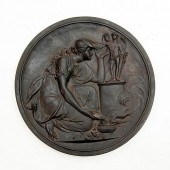 WEDGWOOD BLACK BASALT WALL
WEDGWOOD BLACK BASALT WALL PLAQUE, SACRIFICE TO HYMENRare neoclassical plaque with a relief of a ritual sacrifice to the roman goddess Concordia and Greek god hymen. Elegantly draped woman pouring liberations into a fire before statue of the deities. Wedgwood impressed to back. Depth: 0.75. Issued: c. 1787 Dimensions: 10.25"Dia. Manufacturer: Wedgwood Country of Origin: England Condition: Age related wear.
WEDGWOOD BLACK BASALT WALL
WEDGWOOD BLACK BASALT WALL PLAQUE, SACRIFICE TO HYMENRare neoclassical plaque with a relief of a ritual sacrifice to the roman goddess Concordia and Greek god hymen. Elegantly draped woman pouring liberations into a fire before statue of the deities. Wedgwood impressed to back. Depth: 0.75. Issued: c. 1787 Dimensions: 10.25"Dia. Manufacturer: Wedgwood Country of Origin: England Condition: Age related wear. -
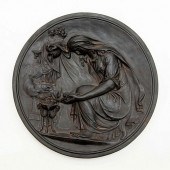 WEDGWOOD BLACK BASALT WALL
WEDGWOOD BLACK BASALT WALL PLAQUE, SACRIFICE TO HYMENRare neoclassical plaque with a high relief of a ritual sacrifice to the roman goddess Concordia and Greek god hymen. Elegantly draped woman pouring liberations into a fire before statue of the deities. Wedgwood impressed to back. Issued: c. 1787 Dimensions: 10.25"Dia. Manufacturer: Wedgwood Country of Origin: England Condition: Age related wear.
WEDGWOOD BLACK BASALT WALL
WEDGWOOD BLACK BASALT WALL PLAQUE, SACRIFICE TO HYMENRare neoclassical plaque with a high relief of a ritual sacrifice to the roman goddess Concordia and Greek god hymen. Elegantly draped woman pouring liberations into a fire before statue of the deities. Wedgwood impressed to back. Issued: c. 1787 Dimensions: 10.25"Dia. Manufacturer: Wedgwood Country of Origin: England Condition: Age related wear. -
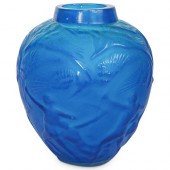 AFTER RENE LALIQUE ARCHERS ELECTRIC
AFTER RENE LALIQUE ARCHERS ELECTRIC BLUE GLASS VASEDESCRIPTION: After Rene Lalique archers electric blue glass vase with mid relief motifs featuring a continuous frieze of classical male archers and swooping birds. This is a vase after "The Archers" Rene Lalique vase created in 1921 with its ancient decoration of eagles and hunters symbolizing liberation and freedom. CIRCA: 20th Century. DIMENSIONS: W: 8 1/2" H: 10". Have a similar item to sell? Contact: Info@Akibaantiques.com. CONDITION: Vintage condition. See lot description for details on item condition. More detailed condition requests can be obtained via email (info@akibaantiques.com) or SMS(305)-332-9274. Any condition statement given, as a courtesy to a client, is only an opinion and should not be treated as a statement of fact. Akiba Antiques shall have no responsibility for any error or omission."
AFTER RENE LALIQUE ARCHERS ELECTRIC
AFTER RENE LALIQUE ARCHERS ELECTRIC BLUE GLASS VASEDESCRIPTION: After Rene Lalique archers electric blue glass vase with mid relief motifs featuring a continuous frieze of classical male archers and swooping birds. This is a vase after "The Archers" Rene Lalique vase created in 1921 with its ancient decoration of eagles and hunters symbolizing liberation and freedom. CIRCA: 20th Century. DIMENSIONS: W: 8 1/2" H: 10". Have a similar item to sell? Contact: Info@Akibaantiques.com. CONDITION: Vintage condition. See lot description for details on item condition. More detailed condition requests can be obtained via email (info@akibaantiques.com) or SMS(305)-332-9274. Any condition statement given, as a courtesy to a client, is only an opinion and should not be treated as a statement of fact. Akiba Antiques shall have no responsibility for any error or omission." -
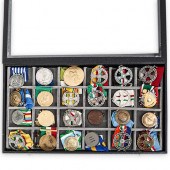 (24PC) WORLD MEDAL
(24PC) WORLD MEDAL COLLECTIONDESCRIPTION: (24Pc) World Medal collection in glass window display case. includes: (1) Somalia medal with ribbon. (H: 5.5" x D: 1.5") (1) Per La Pubblica Sicurezza with ribbon. (H: 6.25" x D: 1.5") (1) Iraq 2003 Pro Humanitate with ribbon. (H: 4.5" x D: 1.5") (1) Albania Pro Humanitate with ribbon. (H: 5.5" x D: 1.5") (1) Vespri Siciliani with ribbon. (H: 5" x L: 1.5") (1) Inter Arma Caritas with ribbon. (H: 4.25" x L: 1.75") (1) Liberation of Kuwait with ribbon. (H: 4.5" x D: 1.75") (1) NATO Commemorative in service of peace and freedom, with ribbon. (H: 3" x D: 1.5") (1) Anti-Piracy Mission Medal with ribbon. (H: 4" x D: 1.5") (1) Mauritian Medal for Military Merit with ribbon. (H: 3.5" x D: 2") (1) Mauritian Medal for Military Merit with ribbon. (H: 4" x D: 1.5") (1) UN in the service of peace medal with ribbon. (H: 5.5"x D: 1.5") (1) 1991 Kuwait medal with ribbon. (H: 3.5" x D: 1.5") (1) Per La Pace Sanai with ribbon. (H: 4" x D: 1.5") (1) Althea Pro Pace Unum with ribbon. (H: 5.25" x D: 1.25") (1) Golfo Persico medal with ribbon. (H: 4.5" x D: 1.5") (1) Kuwait medal with ribbon. (H: 3.5" x D: 1.5") (1) In the service of peace and freedom medal. (H: 5" x D: 1.5") (1) Protezione Civile Etna 1991-1992 (H: 3.5" x D: 1.25") (1) Per La Pace Libano medal with ribbon. (H: 3.75" x D: 1.5") (1) Per La Sicurezza medal. (H: 3.5" x L: 1.5") (1) UN in the service of peace medal. (H: 4" x D: 1.25") (1) Al Merito Di Lungo Comando medal with ribbon. (H: 3.5" x D: 1.5") (1) Medalha Vitoria medal. (D: 1.25") (1) Case. (H: 1" x W: 8.5" x L: 14.75") CIRCA: 20th Cent. DIMENSIONS: See Above. CONDITION: Great condition. See lot description for details on item condition. More detailed condition requests can be obtained via email (info@akibaantiques.com) or SMS (305) 333-4134. Any condition statement given, as a courtesy to a client, is only an opinion and should not be treated as a statement of fact. Akiba Antiques shall have no responsibility for any error or omission.
(24PC) WORLD MEDAL
(24PC) WORLD MEDAL COLLECTIONDESCRIPTION: (24Pc) World Medal collection in glass window display case. includes: (1) Somalia medal with ribbon. (H: 5.5" x D: 1.5") (1) Per La Pubblica Sicurezza with ribbon. (H: 6.25" x D: 1.5") (1) Iraq 2003 Pro Humanitate with ribbon. (H: 4.5" x D: 1.5") (1) Albania Pro Humanitate with ribbon. (H: 5.5" x D: 1.5") (1) Vespri Siciliani with ribbon. (H: 5" x L: 1.5") (1) Inter Arma Caritas with ribbon. (H: 4.25" x L: 1.75") (1) Liberation of Kuwait with ribbon. (H: 4.5" x D: 1.75") (1) NATO Commemorative in service of peace and freedom, with ribbon. (H: 3" x D: 1.5") (1) Anti-Piracy Mission Medal with ribbon. (H: 4" x D: 1.5") (1) Mauritian Medal for Military Merit with ribbon. (H: 3.5" x D: 2") (1) Mauritian Medal for Military Merit with ribbon. (H: 4" x D: 1.5") (1) UN in the service of peace medal with ribbon. (H: 5.5"x D: 1.5") (1) 1991 Kuwait medal with ribbon. (H: 3.5" x D: 1.5") (1) Per La Pace Sanai with ribbon. (H: 4" x D: 1.5") (1) Althea Pro Pace Unum with ribbon. (H: 5.25" x D: 1.25") (1) Golfo Persico medal with ribbon. (H: 4.5" x D: 1.5") (1) Kuwait medal with ribbon. (H: 3.5" x D: 1.5") (1) In the service of peace and freedom medal. (H: 5" x D: 1.5") (1) Protezione Civile Etna 1991-1992 (H: 3.5" x D: 1.25") (1) Per La Pace Libano medal with ribbon. (H: 3.75" x D: 1.5") (1) Per La Sicurezza medal. (H: 3.5" x L: 1.5") (1) UN in the service of peace medal. (H: 4" x D: 1.25") (1) Al Merito Di Lungo Comando medal with ribbon. (H: 3.5" x D: 1.5") (1) Medalha Vitoria medal. (D: 1.25") (1) Case. (H: 1" x W: 8.5" x L: 14.75") CIRCA: 20th Cent. DIMENSIONS: See Above. CONDITION: Great condition. See lot description for details on item condition. More detailed condition requests can be obtained via email (info@akibaantiques.com) or SMS (305) 333-4134. Any condition statement given, as a courtesy to a client, is only an opinion and should not be treated as a statement of fact. Akiba Antiques shall have no responsibility for any error or omission. -
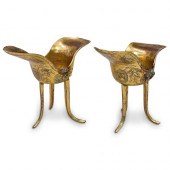 PAIR OF CHINESE IMPERIAL GILT
PAIR OF CHINESE IMPERIAL GILT COPPER LIBERATION CUPSDESCRIPTION: A pair of Chinese gilt copper liberation cups with floral motifs. CIRCA: 17th-18th Century. ORIGIN: China DIMENSIONS: H: 4" x W: 2" x L: 4.5" Have a similar item to sell? Contact: Info@Akibaantiques.com. CONDITION: Great condition. See lot description for details on item condition. More detailed condition requests can be obtained via email (info@akibaantiques.com) or SMS(305)-332-9274. Any condition statement given, as a courtesy to a client, is only an opinion and should not be treated as a statement of fact. Akiba Antiques shall have no responsibility for any error or omission."
PAIR OF CHINESE IMPERIAL GILT
PAIR OF CHINESE IMPERIAL GILT COPPER LIBERATION CUPSDESCRIPTION: A pair of Chinese gilt copper liberation cups with floral motifs. CIRCA: 17th-18th Century. ORIGIN: China DIMENSIONS: H: 4" x W: 2" x L: 4.5" Have a similar item to sell? Contact: Info@Akibaantiques.com. CONDITION: Great condition. See lot description for details on item condition. More detailed condition requests can be obtained via email (info@akibaantiques.com) or SMS(305)-332-9274. Any condition statement given, as a courtesy to a client, is only an opinion and should not be treated as a statement of fact. Akiba Antiques shall have no responsibility for any error or omission." -
 FRIDA KAHLO "AUTORRETRATO" MIXED
FRIDA KAHLO "AUTORRETRATO" MIXED MEDIAFrida Kahlo (Mexico, 1907 - 1954) unframed watercolor, pastel, & charcoal on paper depicting a portrait of Frida Kahlo and titled "Autorretrato", executed in 1941. Measures 18-1/2" in height with width of 12-1/2" & signed to lower left "Frida Kahlo 1941". All measurements are approximate. Complete with certificate of authenticity & letter of provenance, please see photographs. Provenance: comes from the estate of a prominent Texas collector. Magdalena Carmen Frida Calderon (Frida Kahlo) was born on July 6, 1907 in Mexico City, the daughter of a German Jewish father & a Mexican mother. She lived her adult life in the shadow of her husband, famed muralist & Mexican national hero Diego Rivera whom she had known since childhood. They embarked on their violent courtship following his divorce from his second wife. The were both temperamental & noisy Communists, & she proudly proclaimed that she had never been expelled from the communist party, as Diego was. He was obese, unfaithful, & psychologically abusive, yet Frida retaliated with her own bisexual affairs. Kahlo once called Rivera "the other accident" in her life, and she lamented her inability to possess him completely. A grisly accident occurred when she was a teenager: a streetcar hit the bus in which she was riding and drove a handrail into her abdomen and out her vagina. As a result her pregnancies resulted in miscarriages and abortions. Semi-crippled and in constant pain, she required several ghastly operations and enough liquor to make her a probable alcoholic. She was extremely loyal to her country; she altered her birthdate to coincide wth the start of the 1910 Mexican Revolution, and to her politics; at her cremation a hammer and sickle was draped over the casket. She didn't enjoy a long enough career to make it into the coffee-table books while she she was still alive. In 1939, after Kahlo returned to Mexico & after some success with exhibitions of her work in Paris & New York, she & Rivera divorced. Her health deteriorated, yet she continued to paint. She and Rivera remarried in 1940, but her physical condition worsened. After her death she was transformed from the "wife of Diego Rivera" to the art world's version of Sylvia Plath, in many opinions. The resurrection of Kahlo started in the 1970s, when her work began to generate excitement in the women's liberation movement. But there always has been much controversy about the worth of her work. She was hailed by the Surrealists and unabashedly admired by Picasso; yet in Mexico itself there are many who feel she is over-rated. She is the subject of numerous biographies, exhibitions and documentary films, not to mention souvenir T-shirts, calendars and posters. For women and feminists, especially, she is a heroine who overcame great odds to create an identity for herself in art. She died in 1954.
FRIDA KAHLO "AUTORRETRATO" MIXED
FRIDA KAHLO "AUTORRETRATO" MIXED MEDIAFrida Kahlo (Mexico, 1907 - 1954) unframed watercolor, pastel, & charcoal on paper depicting a portrait of Frida Kahlo and titled "Autorretrato", executed in 1941. Measures 18-1/2" in height with width of 12-1/2" & signed to lower left "Frida Kahlo 1941". All measurements are approximate. Complete with certificate of authenticity & letter of provenance, please see photographs. Provenance: comes from the estate of a prominent Texas collector. Magdalena Carmen Frida Calderon (Frida Kahlo) was born on July 6, 1907 in Mexico City, the daughter of a German Jewish father & a Mexican mother. She lived her adult life in the shadow of her husband, famed muralist & Mexican national hero Diego Rivera whom she had known since childhood. They embarked on their violent courtship following his divorce from his second wife. The were both temperamental & noisy Communists, & she proudly proclaimed that she had never been expelled from the communist party, as Diego was. He was obese, unfaithful, & psychologically abusive, yet Frida retaliated with her own bisexual affairs. Kahlo once called Rivera "the other accident" in her life, and she lamented her inability to possess him completely. A grisly accident occurred when she was a teenager: a streetcar hit the bus in which she was riding and drove a handrail into her abdomen and out her vagina. As a result her pregnancies resulted in miscarriages and abortions. Semi-crippled and in constant pain, she required several ghastly operations and enough liquor to make her a probable alcoholic. She was extremely loyal to her country; she altered her birthdate to coincide wth the start of the 1910 Mexican Revolution, and to her politics; at her cremation a hammer and sickle was draped over the casket. She didn't enjoy a long enough career to make it into the coffee-table books while she she was still alive. In 1939, after Kahlo returned to Mexico & after some success with exhibitions of her work in Paris & New York, she & Rivera divorced. Her health deteriorated, yet she continued to paint. She and Rivera remarried in 1940, but her physical condition worsened. After her death she was transformed from the "wife of Diego Rivera" to the art world's version of Sylvia Plath, in many opinions. The resurrection of Kahlo started in the 1970s, when her work began to generate excitement in the women's liberation movement. But there always has been much controversy about the worth of her work. She was hailed by the Surrealists and unabashedly admired by Picasso; yet in Mexico itself there are many who feel she is over-rated. She is the subject of numerous biographies, exhibitions and documentary films, not to mention souvenir T-shirts, calendars and posters. For women and feminists, especially, she is a heroine who overcame great odds to create an identity for herself in art. She died in 1954. -
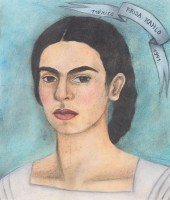 FRIDA KAHLO "AUTO RETRATO" PASTEL
FRIDA KAHLO "AUTO RETRATO" PASTEL DRAWING, C 1941Frida Kahlo (Mexico, 1907 - 1954) unframed pastel drawing on paper depicting a portrait of Frida Kahlo and titled "Auto Retrato" or "Self Portrait", executed in 1941. Measures 15-7/8" in height with width of 13-1/2" & signed to uppper right "Mexico Frida Kahlo 1941". All measurements are approximate. Complete with certificate of authenticity & letter of provenance, please see photographs. Also included is the original bill of sale signed by Friday Kahlo, wherein this piece was originally purchased by the actress Paulette Goddard on January 3, 1941. This piece was probably a commissioned piece, note dates. (See photographs for this as well.) Provenance: comes from the estate of a prominent Texas collector, who's family had acquired it as a gift from the actress Paulette Goddard. Magdalena Carmen Frida Calderon (Frida Kahlo) was born on July 6, 1907 in Mexico City, the daughter of a German Jewish father & a Mexican mother. She lived her adult life in the shadow of her husband, famed muralist & Mexican national hero Diego Rivera whom she had known since childhood. They embarked on their violent courtship following his divorce from his second wife. The were both temperamental & noisy Communists, & she proudly proclaimed that she had never been expelled from the communist party, as Diego was. He was obese, unfaithful, & psychologically abusive, yet Frida retaliated with her own bisexual affairs. Kahlo once called Rivera "the other accident" in her life, and she lamented her inability to possess him completely. A grisly accident occurred when she was a teenager: a streetcar hit the bus in which she was riding and drove a handrail into her abdomen and out her vagina. As a result her pregnancies resulted in miscarriages and abortions. Semi-crippled and in constant pain, she required several ghastly operations and enough liquor to make her a probable alcoholic. She was extremely loyal to her country; she altered her birthdate to coincide wth the start of the 1910 Mexican Revolution, and to her politics; at her cremation a hammer and sickle was draped over the casket. She didn't enjoy a long enough career to make it into the coffee-table books while she she was still alive. In 1939, after Kahlo returned to Mexico & after some success with exhibitions of her work in Paris & New York, she & Rivera divorced. Her health deteriorated, yet she continued to paint. She and Rivera remarried in 1940, but her physical condition worsened. After her death she was transformed from the "wife of Diego Rivera" to the art world's version of Sylvia Plath, in many opinions. The resurrection of Kahlo started in the 1970s, when her work began to generate excitement in the women's liberation movement. But there always has been much controversy about the worth of her work. She was hailed by the Surrealists and unabashedly admired by Picasso; yet in Mexico itself there are many who feel she is over-rated. She is the subject of numerous biographies, exhibitions and documentary films, not to mention souvenir T-shirts, calendars and posters. For women and feminists, especially, she is a heroine who overcame great odds to create an identity for herself in art. She died in 1954.
FRIDA KAHLO "AUTO RETRATO" PASTEL
FRIDA KAHLO "AUTO RETRATO" PASTEL DRAWING, C 1941Frida Kahlo (Mexico, 1907 - 1954) unframed pastel drawing on paper depicting a portrait of Frida Kahlo and titled "Auto Retrato" or "Self Portrait", executed in 1941. Measures 15-7/8" in height with width of 13-1/2" & signed to uppper right "Mexico Frida Kahlo 1941". All measurements are approximate. Complete with certificate of authenticity & letter of provenance, please see photographs. Also included is the original bill of sale signed by Friday Kahlo, wherein this piece was originally purchased by the actress Paulette Goddard on January 3, 1941. This piece was probably a commissioned piece, note dates. (See photographs for this as well.) Provenance: comes from the estate of a prominent Texas collector, who's family had acquired it as a gift from the actress Paulette Goddard. Magdalena Carmen Frida Calderon (Frida Kahlo) was born on July 6, 1907 in Mexico City, the daughter of a German Jewish father & a Mexican mother. She lived her adult life in the shadow of her husband, famed muralist & Mexican national hero Diego Rivera whom she had known since childhood. They embarked on their violent courtship following his divorce from his second wife. The were both temperamental & noisy Communists, & she proudly proclaimed that she had never been expelled from the communist party, as Diego was. He was obese, unfaithful, & psychologically abusive, yet Frida retaliated with her own bisexual affairs. Kahlo once called Rivera "the other accident" in her life, and she lamented her inability to possess him completely. A grisly accident occurred when she was a teenager: a streetcar hit the bus in which she was riding and drove a handrail into her abdomen and out her vagina. As a result her pregnancies resulted in miscarriages and abortions. Semi-crippled and in constant pain, she required several ghastly operations and enough liquor to make her a probable alcoholic. She was extremely loyal to her country; she altered her birthdate to coincide wth the start of the 1910 Mexican Revolution, and to her politics; at her cremation a hammer and sickle was draped over the casket. She didn't enjoy a long enough career to make it into the coffee-table books while she she was still alive. In 1939, after Kahlo returned to Mexico & after some success with exhibitions of her work in Paris & New York, she & Rivera divorced. Her health deteriorated, yet she continued to paint. She and Rivera remarried in 1940, but her physical condition worsened. After her death she was transformed from the "wife of Diego Rivera" to the art world's version of Sylvia Plath, in many opinions. The resurrection of Kahlo started in the 1970s, when her work began to generate excitement in the women's liberation movement. But there always has been much controversy about the worth of her work. She was hailed by the Surrealists and unabashedly admired by Picasso; yet in Mexico itself there are many who feel she is over-rated. She is the subject of numerous biographies, exhibitions and documentary films, not to mention souvenir T-shirts, calendars and posters. For women and feminists, especially, she is a heroine who overcame great odds to create an identity for herself in art. She died in 1954. -
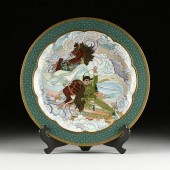 A CHINESE PROPAGANDA ENAMELED
A CHINESE PROPAGANDA ENAMELED BRONZE CLOISSONE CHARGER,...A CHINESE PROPAGANDA ENAMELED BRONZE CLOISSONE CHARGER, PEOPLE'S LIBERATION ARMY, 1950s, polychrome enamel in bronze cloisonne, a scene of a fierce soldier defending a horse concealing technology on a rocky railroad within pink, purple and blue swirling clouds, floriform edge with a snowflake and diaper border. Height: 1 1/2" Diameter: 20 3/8" Condition: Some surface wear and patina. Simpson Galleries strongly encourages in-person inspection of items by the bidder. Statements by Simpson Galleries regarding the condition of objects are for guidance only and should not be relied upon as statements of fact and do not constitute a representation, warranty, or assumption of liability by Simpson Galleries. All lots offered are sold "AS IS."
A CHINESE PROPAGANDA ENAMELED
A CHINESE PROPAGANDA ENAMELED BRONZE CLOISSONE CHARGER,...A CHINESE PROPAGANDA ENAMELED BRONZE CLOISSONE CHARGER, PEOPLE'S LIBERATION ARMY, 1950s, polychrome enamel in bronze cloisonne, a scene of a fierce soldier defending a horse concealing technology on a rocky railroad within pink, purple and blue swirling clouds, floriform edge with a snowflake and diaper border. Height: 1 1/2" Diameter: 20 3/8" Condition: Some surface wear and patina. Simpson Galleries strongly encourages in-person inspection of items by the bidder. Statements by Simpson Galleries regarding the condition of objects are for guidance only and should not be relied upon as statements of fact and do not constitute a representation, warranty, or assumption of liability by Simpson Galleries. All lots offered are sold "AS IS." -
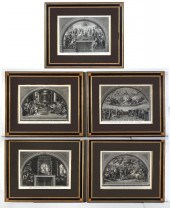 5 EARLY 19TH CENTURY MOCHETTI
5 EARLY 19TH CENTURY MOCHETTI ENGRAVINGS: ''Pio Septimo Pontifici Opt. Maximo, 4 engravings by Guiseppe Mochetti and 1, ''The Liberation of Saint Peter'' is by Pietro Ghygi. All are published by Franzetti. All measure approx. 15 .25 x 29.25'' sight size, framed 25.25'' x 30.25''. Provenance: Estate of Dr. Peter J. Fischinger, M.D., Ph.D., former Associate Director, National Cancer Institute.
5 EARLY 19TH CENTURY MOCHETTI
5 EARLY 19TH CENTURY MOCHETTI ENGRAVINGS: ''Pio Septimo Pontifici Opt. Maximo, 4 engravings by Guiseppe Mochetti and 1, ''The Liberation of Saint Peter'' is by Pietro Ghygi. All are published by Franzetti. All measure approx. 15 .25 x 29.25'' sight size, framed 25.25'' x 30.25''. Provenance: Estate of Dr. Peter J. Fischinger, M.D., Ph.D., former Associate Director, National Cancer Institute. -
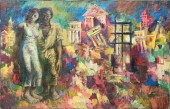 VIDAR, Frede, (Danish,
VIDAR, Frede, (Danish, 1911-1967): ''Welcome Home'', (return of a guerilla to the ? after its liberation of Japs), Oil/Canvas, 25.5'' x 39.5'', signed lower left, unframed, partial label with title affixed verso. CONDITION: Several scattered pinholes with flecks of loss, needs cleaning.
VIDAR, Frede, (Danish,
VIDAR, Frede, (Danish, 1911-1967): ''Welcome Home'', (return of a guerilla to the ? after its liberation of Japs), Oil/Canvas, 25.5'' x 39.5'', signed lower left, unframed, partial label with title affixed verso. CONDITION: Several scattered pinholes with flecks of loss, needs cleaning. -
 (2) JOHN GROTH (1908-1988)
(2) JOHN GROTH (1908-1988) HUNTER, DOG & GEESE(lot of 2) Unframed ink and watercolor drawings on paper, Hunter, Dog and Geese, the largest signed lower right John Groth (Illinois, New York, Texas, 1908-1988), largest: 27"h, 40"w, smallest: 24"h, 18"w *Note: John Growth, artist-correspondent, worked as a WPA artist and art editor of Esquire magazine. During WWII he represented the Chicago Sun and is said to have been in the first jeep that entered Paris after its liberation from the Germans, and later went into Berlin during its surrender. He authored and illustrated two books, one with an introduction by Ernest Hemingway and later illustrated the 1946 World Publishing Co. edition of Hemingway’s book "Men Without Women." He covered five wars including Vietnam. He served as a teacher including time at the University of Texas.*
(2) JOHN GROTH (1908-1988)
(2) JOHN GROTH (1908-1988) HUNTER, DOG & GEESE(lot of 2) Unframed ink and watercolor drawings on paper, Hunter, Dog and Geese, the largest signed lower right John Groth (Illinois, New York, Texas, 1908-1988), largest: 27"h, 40"w, smallest: 24"h, 18"w *Note: John Growth, artist-correspondent, worked as a WPA artist and art editor of Esquire magazine. During WWII he represented the Chicago Sun and is said to have been in the first jeep that entered Paris after its liberation from the Germans, and later went into Berlin during its surrender. He authored and illustrated two books, one with an introduction by Ernest Hemingway and later illustrated the 1946 World Publishing Co. edition of Hemingway’s book "Men Without Women." He covered five wars including Vietnam. He served as a teacher including time at the University of Texas.* -
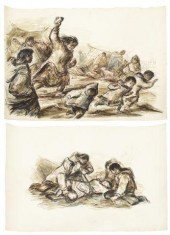 (2) JOHN GROTH (1908-1988) INUIT
(2) JOHN GROTH (1908-1988) INUIT STORY II(lot of 2) Unframed ink and watercolor drawings on paper, Inuit Story II, unsigned, John Groth (Illinois, New York, Texas, 1908-1988), largest: 27"h, 40"w *Note: John Growth, artist-correspondent, worked as a WPA artist and art editor of Esquire magazine. During WWII he represented the Chicago Sun and is said to have been in the first jeep that entered Paris after its liberation from the Germans, and later went into Berlin during its surrender. He authored and illustrated two books, one with an introduction by Ernest Hemingway and later illustrated the 1946 World Publishing Co. edition of Hemingway’s book "Men Without Women." He covered five wars including Vietnam. He served as a teacher including time at the University of Texas.*
(2) JOHN GROTH (1908-1988) INUIT
(2) JOHN GROTH (1908-1988) INUIT STORY II(lot of 2) Unframed ink and watercolor drawings on paper, Inuit Story II, unsigned, John Groth (Illinois, New York, Texas, 1908-1988), largest: 27"h, 40"w *Note: John Growth, artist-correspondent, worked as a WPA artist and art editor of Esquire magazine. During WWII he represented the Chicago Sun and is said to have been in the first jeep that entered Paris after its liberation from the Germans, and later went into Berlin during its surrender. He authored and illustrated two books, one with an introduction by Ernest Hemingway and later illustrated the 1946 World Publishing Co. edition of Hemingway’s book "Men Without Women." He covered five wars including Vietnam. He served as a teacher including time at the University of Texas.* -
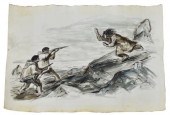 JOHN GROTH (1908-1988) INUIT
JOHN GROTH (1908-1988) INUIT STORY IIIUnframed ink and watercolor drawing on paper, Inuit Story III, signed lower right John Groth (Illinois, New York, Texas, 1908-1988), 27"h, 40"w *Note: John Growth, artist-correspondent, worked as a WPA artist and art editor of Esquire magazine. During WWII he represented the Chicago Sun and is said to have been in the first jeep that entered Paris after its liberation from the Germans, and later went into Berlin during its surrender. He authored and illustrated two books, one with an introduction by Ernest Hemingway and later illustrated the 1946 World Publishing Co. edition of Hemingway’s book "Men Without Women." He covered five wars including Vietnam. He served as a teacher including time at the University of Texas.*
JOHN GROTH (1908-1988) INUIT
JOHN GROTH (1908-1988) INUIT STORY IIIUnframed ink and watercolor drawing on paper, Inuit Story III, signed lower right John Groth (Illinois, New York, Texas, 1908-1988), 27"h, 40"w *Note: John Growth, artist-correspondent, worked as a WPA artist and art editor of Esquire magazine. During WWII he represented the Chicago Sun and is said to have been in the first jeep that entered Paris after its liberation from the Germans, and later went into Berlin during its surrender. He authored and illustrated two books, one with an introduction by Ernest Hemingway and later illustrated the 1946 World Publishing Co. edition of Hemingway’s book "Men Without Women." He covered five wars including Vietnam. He served as a teacher including time at the University of Texas.* -
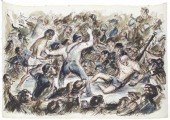 JOHN GROTH (1908-1988) THE BOXER
JOHN GROTH (1908-1988) THE BOXER & THE FIGHTUnframed ink and watercolor drawing on paper, The Boxer and The Fight, signed upper left John Groth (Illinois, New York, Texas, 1908-1988), 27.25"h, 40.5"w *Note: John Growth, artist-correspondent, worked as a WPA artist and art editor of Esquire magazine. During WWII he represented the Chicago Sun and is said to have been in the first jeep that entered Paris after its liberation from the Germans, and later went into Berlin during its surrender. He authored and illustrated two books, one with an introduction by Ernest Hemingway and later illustrated the 1946 World Publishing Co. edition of Hemingway’s book "Men Without Women." He covered five wars including Vietnam. He served as a teacher including time at the University of Texas.*
JOHN GROTH (1908-1988) THE BOXER
JOHN GROTH (1908-1988) THE BOXER & THE FIGHTUnframed ink and watercolor drawing on paper, The Boxer and The Fight, signed upper left John Groth (Illinois, New York, Texas, 1908-1988), 27.25"h, 40.5"w *Note: John Growth, artist-correspondent, worked as a WPA artist and art editor of Esquire magazine. During WWII he represented the Chicago Sun and is said to have been in the first jeep that entered Paris after its liberation from the Germans, and later went into Berlin during its surrender. He authored and illustrated two books, one with an introduction by Ernest Hemingway and later illustrated the 1946 World Publishing Co. edition of Hemingway’s book "Men Without Women." He covered five wars including Vietnam. He served as a teacher including time at the University of Texas.* -
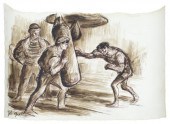 JOHN GROTH (1908-1988) BOXER &
JOHN GROTH (1908-1988) BOXER & PUNCHING BAGUnframed ink and watercolor drawing on paper, Boxer and Punching Bag, signed lower left John Groth (Illinois, New York, Texas, 1908-1988), 27.25"h, 40.25"w *Note: John Growth, artist-correspondent, worked as a WPA artist and art editor of Esquire magazine. During WWII he represented the Chicago Sun and is said to have been in the first jeep that entered Paris after its liberation from the Germans, and later went into Berlin during its surrender. He authored and illustrated two books, one with an introduction by Ernest Hemingway and later illustrated the 1946 World Publishing Co. edition of Hemingway’s book "Men Without Women." He covered five wars including Vietnam. He served as a teacher including time at the University of Texas.*
JOHN GROTH (1908-1988) BOXER &
JOHN GROTH (1908-1988) BOXER & PUNCHING BAGUnframed ink and watercolor drawing on paper, Boxer and Punching Bag, signed lower left John Groth (Illinois, New York, Texas, 1908-1988), 27.25"h, 40.25"w *Note: John Growth, artist-correspondent, worked as a WPA artist and art editor of Esquire magazine. During WWII he represented the Chicago Sun and is said to have been in the first jeep that entered Paris after its liberation from the Germans, and later went into Berlin during its surrender. He authored and illustrated two books, one with an introduction by Ernest Hemingway and later illustrated the 1946 World Publishing Co. edition of Hemingway’s book "Men Without Women." He covered five wars including Vietnam. He served as a teacher including time at the University of Texas.* -
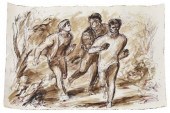 JOHN GROTH (1908-1988) BOXER
JOHN GROTH (1908-1988) BOXER TRAINING RUNUnframed ink and watercolor drawing on paper, Boxer Training Run, signed upper left John Groth (Illinois, New York, Texas, 1908-1988), 27.25"h, 40.25"w *Note: John Growth, artist-correspondent, worked as a WPA artist and art editor of Esquire magazine. During WWII he represented the Chicago Sun and is said to have been in the first jeep that entered Paris after its liberation from the Germans, and later went into Berlin during its surrender. He authored and illustrated two books, one with an introduction by Ernest Hemingway and later illustrated the 1946 World Publishing Co. edition of Hemingway’s book "Men Without Women." He covered five wars including Vietnam. He served as a teacher including time at the University of Texas.*
JOHN GROTH (1908-1988) BOXER
JOHN GROTH (1908-1988) BOXER TRAINING RUNUnframed ink and watercolor drawing on paper, Boxer Training Run, signed upper left John Groth (Illinois, New York, Texas, 1908-1988), 27.25"h, 40.25"w *Note: John Growth, artist-correspondent, worked as a WPA artist and art editor of Esquire magazine. During WWII he represented the Chicago Sun and is said to have been in the first jeep that entered Paris after its liberation from the Germans, and later went into Berlin during its surrender. He authored and illustrated two books, one with an introduction by Ernest Hemingway and later illustrated the 1946 World Publishing Co. edition of Hemingway’s book "Men Without Women." He covered five wars including Vietnam. He served as a teacher including time at the University of Texas.* -
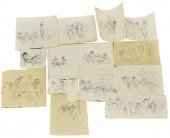 15) JOHN GROTH (1908-1988)
15) JOHN GROTH (1908-1988) STUDIES / ILLUSTRATIONS(lot of 15) Unframed ink preliminary studies, drawings on paper depicting various Vietnam scenes and other figures, fourteen signed John Groth (Illinois, New York, Texas, 1908-1988), largest: 20"h, 21"w *Note: John Growth, artist-correspondent, worked as a WPA artist and art editor of Esquire magazine. During WWII he represented the Chicago Sun and is said to have been in the first jeep that entered Paris after its liberation from the Germans, and later went into Berlin during its surrender. He authored and illustrated two books, one with an introduction by Ernest Hemingway and later illustrated the 1946 World Publishing Co. edition of Hemingway’s book "Men Without Women." He covered five wars including Vietnam. He served as a teacher including time at the University of Texas.*
15) JOHN GROTH (1908-1988)
15) JOHN GROTH (1908-1988) STUDIES / ILLUSTRATIONS(lot of 15) Unframed ink preliminary studies, drawings on paper depicting various Vietnam scenes and other figures, fourteen signed John Groth (Illinois, New York, Texas, 1908-1988), largest: 20"h, 21"w *Note: John Growth, artist-correspondent, worked as a WPA artist and art editor of Esquire magazine. During WWII he represented the Chicago Sun and is said to have been in the first jeep that entered Paris after its liberation from the Germans, and later went into Berlin during its surrender. He authored and illustrated two books, one with an introduction by Ernest Hemingway and later illustrated the 1946 World Publishing Co. edition of Hemingway’s book "Men Without Women." He covered five wars including Vietnam. He served as a teacher including time at the University of Texas.* -
 ADAM (GROCHOWSKI) GRANT
ADAM (GROCHOWSKI) GRANT (POLISH/AMERICAN. 1924-1992)Two Female Nudes, 1964. Signed, dated l/r. Oil on Canvas. 43 by 50 in. Provenance: Private Collection, and friend of the Artist, purchased directly from the artist. Provenance: Private Collection, and friend of the Artist, purchased directly from the artist. Adam (Grochowski) Grant: An exceptional figurative painter, Grant was born in Warsaw,Poland in 1924, as Adam Grochowski. The young Adam was discouraged by his family from pursuing a professional art career, His father would repeatedly claim, his paintings would never earn the price for his bread. In his teens, Adam was sent to the Nazi concentration camp of Auschwitz Mauthausen, where he literally traded his art for bread. In addition to grueling physical labor, the camp officers assigned him to create paintings for the camps. After his liberation, Adam spent five years in a refugee camp, again using his art to provide hope and employment. Adam emigrated to the United States in 1950, securing a job with the Palmer Paint Company in Detroit, MI., where produced the now-legendary Paint By Numbers kits. There, Adam met fellow designer and future wife, Margaret “Peggy” Brennan Americanizing his name, the new Mr. and Mrs. Grant moved to Toledo, Ohio, where Peggy managed his fine art career and Adam painted until his death in 1992. Adam Grant’s paintings were during his lifetime widely exhibited in galleries, as well as juried and solo exhibitions throughout the world. He was the featured painter in the January 1973 edition of American Artist. In recent years. Since his death, his wife Peggy has organized and facilitated exhibits of his work in Ohio, Indiana, Washington, Poland and Saudi Arabia. His work can be seen in many prestigious private, corporate and public collections, including, The Collegium Maius Museum-Krakow, Poland; the Butler Institute of American Art, Youngstown, OH; Midwest Museum of American Art,; The University of Toledo; the Polish Embassy in Riyadh, Saudi Arabia; and the Auschwitz Museum, Poland. In 2011,Adam Grant’s work was accepted as a part of the permanent collection at the inauguration of the Polish History Museum in Warsaw. Credit for and a special thanks to 20 NORTH GALLERY, Toledo, OH for the use of the above, Adam Grant biography.
ADAM (GROCHOWSKI) GRANT
ADAM (GROCHOWSKI) GRANT (POLISH/AMERICAN. 1924-1992)Two Female Nudes, 1964. Signed, dated l/r. Oil on Canvas. 43 by 50 in. Provenance: Private Collection, and friend of the Artist, purchased directly from the artist. Provenance: Private Collection, and friend of the Artist, purchased directly from the artist. Adam (Grochowski) Grant: An exceptional figurative painter, Grant was born in Warsaw,Poland in 1924, as Adam Grochowski. The young Adam was discouraged by his family from pursuing a professional art career, His father would repeatedly claim, his paintings would never earn the price for his bread. In his teens, Adam was sent to the Nazi concentration camp of Auschwitz Mauthausen, where he literally traded his art for bread. In addition to grueling physical labor, the camp officers assigned him to create paintings for the camps. After his liberation, Adam spent five years in a refugee camp, again using his art to provide hope and employment. Adam emigrated to the United States in 1950, securing a job with the Palmer Paint Company in Detroit, MI., where produced the now-legendary Paint By Numbers kits. There, Adam met fellow designer and future wife, Margaret “Peggy” Brennan Americanizing his name, the new Mr. and Mrs. Grant moved to Toledo, Ohio, where Peggy managed his fine art career and Adam painted until his death in 1992. Adam Grant’s paintings were during his lifetime widely exhibited in galleries, as well as juried and solo exhibitions throughout the world. He was the featured painter in the January 1973 edition of American Artist. In recent years. Since his death, his wife Peggy has organized and facilitated exhibits of his work in Ohio, Indiana, Washington, Poland and Saudi Arabia. His work can be seen in many prestigious private, corporate and public collections, including, The Collegium Maius Museum-Krakow, Poland; the Butler Institute of American Art, Youngstown, OH; Midwest Museum of American Art,; The University of Toledo; the Polish Embassy in Riyadh, Saudi Arabia; and the Auschwitz Museum, Poland. In 2011,Adam Grant’s work was accepted as a part of the permanent collection at the inauguration of the Polish History Museum in Warsaw. Credit for and a special thanks to 20 NORTH GALLERY, Toledo, OH for the use of the above, Adam Grant biography.
...many more examples with full details are available to our members - Learn more
